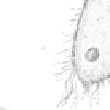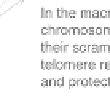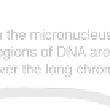Information Technology Reference
In-Depth Information
chromosomes in the micronucleus contains on average approximately 10
7
base-
pairs (bp) in
Oxytricha
species and approximately 18
10
6
bp in
Stylonichia
lemnae
[17]. The size of the DNA molecules in the macronucleus is, in con-
trast, very small. In various
Oxytricha
species and
S. lemnae
, macronuclear
DNA molecules range in size from 400 to 15,000 bp with most molecules in
the 1000-8000 bp range [18].
Macronuclear DNA sequences are derived from the micronuclear sequences
through a series of DNA rearrangements as follows. The segments that to-
gether constitute a macronuclear sequence (
macronuclear destined sequences
or MDSs) are present as sub-sequences in the micronuclear DNA. However,
in the micronuclear DNA, MDSs are interspersed with long DNA sequences
(
internal eliminated sequences
or IESs) that are excised in the micronucleus
to macronucleus differentiation. (Note that excision of IESs from micronuclear
DNA is distinct from excision of introns, which occurs at the RNA level after
transcription of macronuclear DNA.) IESs and intergenic DNA represent large
regions of the micronuclear DNA. In
Oxytricha
species, only 4% of the micro-
nuclear DNA represents macronuclear destined sequences, while in
S. lemnae
that proportion is still smaller, 2% [18].
In addition, in some spirotrich micronuclear genes, the MDSs are present in a
permuted order in the micronuclear DNA, relative to the “correct” macronuclear
order [18], as shown in Figure 10.1. For example, the micronuclear actin I gene
in
Oxytricha nova
consists of nine MDSs separated by eight IESs. The order of
MDSs in the micronucleus is 3-4-6-5-7-9-2-1-8 [19].
×
Figure 10.1
Overview of gene unscrambling. Dispersed coding macronuclear
destined segments 1-7 reassemble during macronuclear development to form the
functional gene copy (top), complete with telomere addition to mark and protect both
ends of the gene. From Landweber and Kari [8].




























